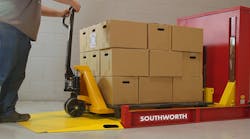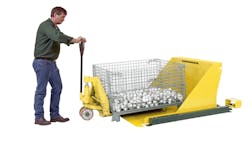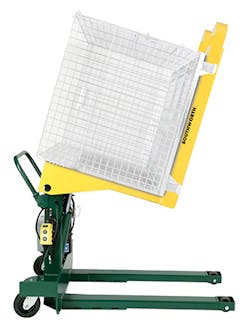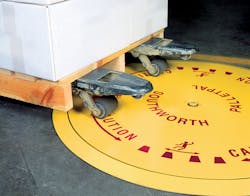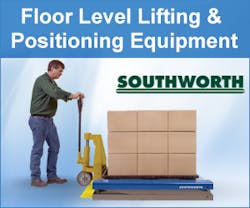Pallet Pleasers: Ergonomic Solutions Increase Productivity
Retail giants like Walmart and Amazon are known for their high-tech distribution centers. These facilities may utilize automated conveying systems and even some robotics that move material. For smaller organizations, investing in such sophisticated equipment may not be an easy decision or it is just economically infeasible. But these companies still need to find effective material handling solutions that increase productivity as they face more pressure to meet demands driven by a strong e-commerce economy and mass customization.
These smaller companies don’t have to install pricey automated systems to increase throughput, nor do they have to sacrifice safety. They can opt for solutions that allow workers to load a pallet, container or cart onto a device that lifts, tilts or rotates the material toward them, says Jim Galante, director of business development at Southworth Products Corp., a maker of ergonomic material handling lifting and positioning equipment.
“We need to appreciate that the majority of people are employed by small companies of under 500 employees,” Galante says. “They don’t have resources for automatic conveyor systems or automated overhead conveyor schemes that can move material. They deal with pallets, carts, and containers.”
The ability to safely access and manually move material without excessive bending or reaching is critical in today’s fast-moving and demanding industrial environment. The industry is contending with an aging and out-of-shape workforce that may be at a greater risk for injury as they try to meet productivity goals, Galante says.
Forklift-Free and Flexible
Pallet jacks, carts, and hand trucks are less costly and present fewer hazards than forklifts, which may make them ideal for smaller companies. The average cost of a forklift is about $30,000, according to Galante. This doesn’t include the cost of the required training for operators or the ongoing maintenance expenses.
But manual transporting equipment, while economical, often lacks the ability to interface with most lifting and positioning equipment. Standard lift tables, pallet level loaders, and container tilters typically have a lowered height of 6 to 10 in., but a hand pallet jack can only raise a pallet or container a few inches above floor level, leaving workers to manually load and unload pallets and containers. This manual loading and unloading requires workers to bend, reach, and stretch. Safety experts have documented how these repetitive motions can lead to debilitating injuries and have a negative impact on productivity.
Pallet jack accessible lifts, level loaders, tilters, and turntables can reduce bending, reaching and twisting to access loads, Galante says. For example, Southworth’s E-Z Reach tilter allows workers to place containers of all types directly on to a wide metal pan-style platform using a hand pallet truck. The pan is attached to a hydraulic tilt unit that can raise the container and position it to the advantage of the worker. In addition, the tilter is compact and includes the option of a side-loading configuration for space-restricted areas.
“In a perfect world, you would like to have equipment that takes up no more space than the container itself,” Galante says.
Another option is a portable tilter that workers can use to retrieve containers from staging areas and move them to a specific work cell. The tilter forks roll under the container, so no other equipment is required to load or unload it.
Even more common than accessing parts in containers is loading and unloading pallets. Galante says there are several hand pallet jack accessible products to make this task faster, safer, and easier. They include floor height lift tables with a lowered height of less than ½-in., pallet level loaders both with and without turntables, and even a lift table with a unique platform cut-out that allows pallet jack forks to roll into the platform opening while the pallet load rolls over the top of it.
Low profile turntables have similar pallet-jack accessible features that allow workers to wheel the unit on to the turntable so they can have 360-deg. access to items on the pallet. By rotating the load, workers can stay in one position throughout the loading process. This allows the work to be done faster and eliminates the physical strain of walking around, or even worse, reaching across the pallet.
There are some cases where it’s just not possible to get a platform low enough to be fed by a hand pallet truck. For instance, a pallet level loader or lift table with an integrated turntable. For a hand pallet truck to access these lifts they would need to be pit mounted, which is often not possible or economically practical, or they require a ramp. If a ramp is required to access equipment, it is important that it be the shallowest angle possible to prevent items from getting hung up on it and to allow loads to roll up it with minimal extra effort.
Tools for the Modern Workforce
The ability to simplify access to material using less expensive and more agile equipment can have a significant impact on worker health and safety, Galante says. More organizations are trying to handle a higher volume of material in space-constricted environments. But forklifts aren’t always practical in these facilities because of the potential danger they pose in tight work areas.
Tilters, turntables, and lifts can help organizations overcome many of the challenges common in today’s material handling workforce, Galante says.
“Unless you’ve been living in a cave, you know there’s a huge worker shortage in the United States,” Galante says. “So now you need to protect your workers and make sure you’re getting the very most out of the people you have, and you want the right working conditions so they don’t leave. You need to keep the people you have.”
Solutions that bring material closer to workers minimize physical exertion and reduce the need to recruit new employees in a tight labor market, Galante says.
For more information, please contact Southworth Products Corp.










